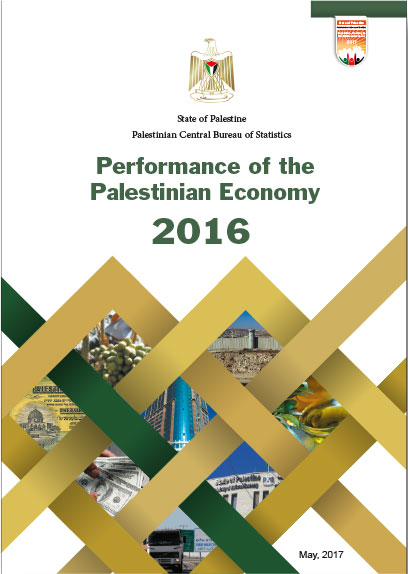Published by The Palestinian Central Bureau of Statistics
78 Pages, available free of charge at PCBS
The Palestinian Central Bureau of Statistics (PCBS) issued an account of the performance of the Palestinian economy in 2016, comparing the relevant indicators of 2016 with 2015. The report outlines major economic indicators, such as the value of GDP at constant prices, GDP per capita, value added by economic activity, household and government expenditure, gross capital formation, exports, imports, trade balance, labor-force participation rate, number of employed persons, nominal and real average daily wage, number of employed persons by economic activity, unemployment rates, prices, balance of payments, international investment position, external debt position, public revenues and expenditures, and banking-sector statistics, which include total credit facilities and total deposits. Comprehensively addressing the various relevant aspects, the report gives full details of relevant numbers and evaluates ongoing trends that are generally dire but show positive developments regarding the deficit and investment activities.
The macroeconomic indicators of GDP show that the total value added of all economic activities increased by 7.7% in the Gaza Strip (due to reconstruction, even though it gravely falls short of actual needs), and 3.0% in the West Bank. Deteriorating conditions characterize the labor market, with a decrease in labor-force participation and an associated increase in the unemployment rate in 2016. The sectoral structure of the Palestinian economy is presented with a focus on the basic activities of agriculture, industry, construction, wholesale and retail trade, transportation and storage, information and communications, and service sectors. Activities in the service sector and its related branches ranked first in the Palestinian economy in terms of value added, followed by wholesale and retail trade, then industry activities, whereas the contributions to the GDP by transportation and storage as well as agriculture activities were low. The movement of prices and purchasing power and their effect on wages and salaries are analyzed; the real average daily wage rose by 5.3%.
The report includes the balance-of-payment indicators, recording financial transactions between residents and non-residents within the economy. A positive trend can be noted, as the value of the trade balance deficit decreased by 0.6% in 2016, compared to 2015, and reached US$ 5,170.5 million. The gross external debt position on the Palestinian economy decreased by 3.7% during 2016, marking a total of US$ 1,606.0 million compared to US$ 1,667.0 million in 2015. The report ends with financial indicators represented by the banking sectors, where the total value of deposits increased by 9.7% in 2016 and reached US$ 10,595.8 million at the end of 2016. Resident individual deposits constituted 66.3% of total deposits, whereas the share of the Palestinian Central Government was 5.0%. The total credit facilities provided by the banking sector in 2016 rose by 17.9% to reach US$ 6,865.9 million.
The comprehensive coverage of the report will be of valuable assistance to researchers and decision makers in the analyzing and planning of national economic policies and the implementation of the Sustainable Development Goals.


